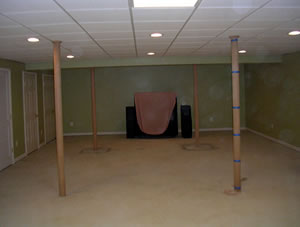- 2 reads

For a lot of homeowners, the easiest way to increase your living space is by finishing the basement. It is also not as expensive as some other strategies for creating space. However, there are a lot more variables for a project that involves the basement due to air quality concerns, moisture buildup and the challenge of adding natural light. Making significant changes to the basement might seem like something one can do on their own, but it would be very beneficial to any homeowner to consult a professional design or basement expert who can point you towards the dos and don’ts of basement remodeling.
Before starting your Basement Remodeling Project, make sure you consider the desired function of the room, the existing conditions that one will have to deal with, the scope of the project, the size of the room, and the layout and space planning. Here is what to think about:
Building Code Issues
One thing to think about off the bat is how many exits does the basement have? Most codes require that there are two ways to get out, which will include the stairs, but may require the addition of a large window well unit for easy escape in case of an emergency. But the upside of this is that the window could also allow some natural light into the room. However, these windows will cause heat loss in the winter, and unless they are installed properly, they may introduce moisture to your basement, giving mold the green light to start multiplying.
There are also some floor-to-ceiling height requirements that may cause some moisture transmission into the floor of the basement. There is often no insulation whatsoever beneath a basement floor, and in order to add it the floor must still remain at the required distance from the ceiling. Now, the energy lost through the floor is minimal, but the thin layer between the basement and the earth may cause comfort problems.
Basement as Healthy Living Space
It is very difficult to create a basement living space that is healthy and provided natural light. The first step is to get a professional home performance audit. The auditor will best be able to determine the ability to control moisture. He will also recommend the area that is driest in the basement to make a room of. It might also be helpful to address air ventilation and humidity separately from the systems of the rest of the house, as the basement is a very peculiar animal. It will also be a help to avoid porous materials like carpeting or upholstered furniture.
Soil Gases
There is an unnaturally long list of chemicals and harmful materials that can be interacting in the soil beneath your basement. Lead, mold, asbestos, persistent pesticides, coal dust, creosote and myriad more hazardous materials could be lurking underneath the basement. With the help of a professional, you should make the decision as to whether the chemicals below your home can be ignored, or would be best taken care of with complete removal or encapsulation.
Moisture Problems and Potential
Increases in the energy efficiency of a building envelope may actually change the equilibrium of your moisture situation that may cause a problem. Energy flow through the home helps to keep it dried out, so when you add new systems to the basement that reduce energy flow, you may be inadvertently causing more moisture throughout. Check out your gutters and downspouts, as well as the wall assemblies and in the floor. You may want to get a moisture meter.
Passive Survivability
Passive survivability is a building’s ability to withstand power, heating, or water failure and still maintain critical life-support conditions. If you live in a part of the country that is at risk of hurricanes, tornadoes, or winter storm outages, consider turning part of your basement into a shelter from the elements. This could be an important sustainability tactic for your family.
Existing Mechanical Systems
You would rather not have unsealed combustion or nonpower-vented gas appliances or mechanical equipment in your finished basement. These items increase the risk of backdraft. Sealed combustion furnaces and boilers and power-vented gas water heaters will not only be more efficient than the previous items, but they will also take up less space. They are also freer to be moved around logistically, as they do not have to be located adjacent to a chimney or a straight-shot chase. These systems will help keep the air quality in the basement safer.Learn more at ReGreenProgram.org.
GREENandSAVE.com is a free resource for anyone that wants to save energy, money, and the environment. The articles, product reviews, online tools, and return on investment calculations are researched from a diverse range of public and private sector sources. Overall, the company is passionate about saving money as well as creating healthy homes, offices, and lifestyles.
For a better idea of which improvements to your home will save you the most money the fastest, take a look at GREENandSAVE’s Return on Investment Table for your
next Home Remodeling project. Or, consider taking a career in the rapidly expanding Green Industry with the EcoAcademy, which is training people across the country for Green Collar Jobs.

